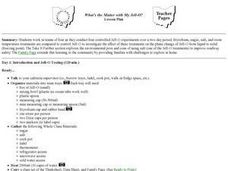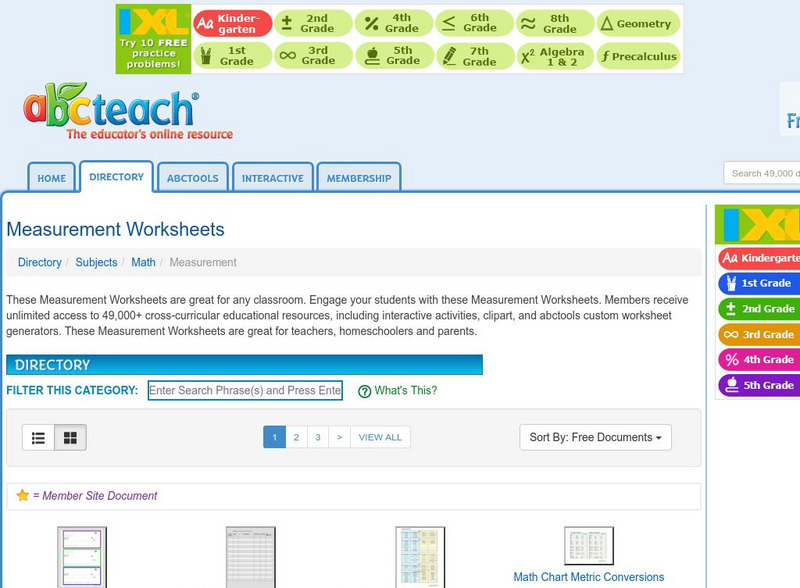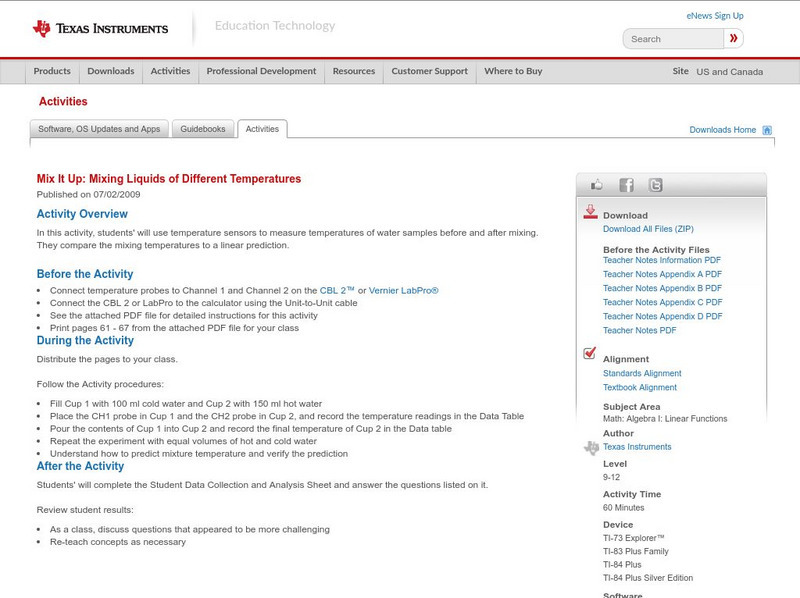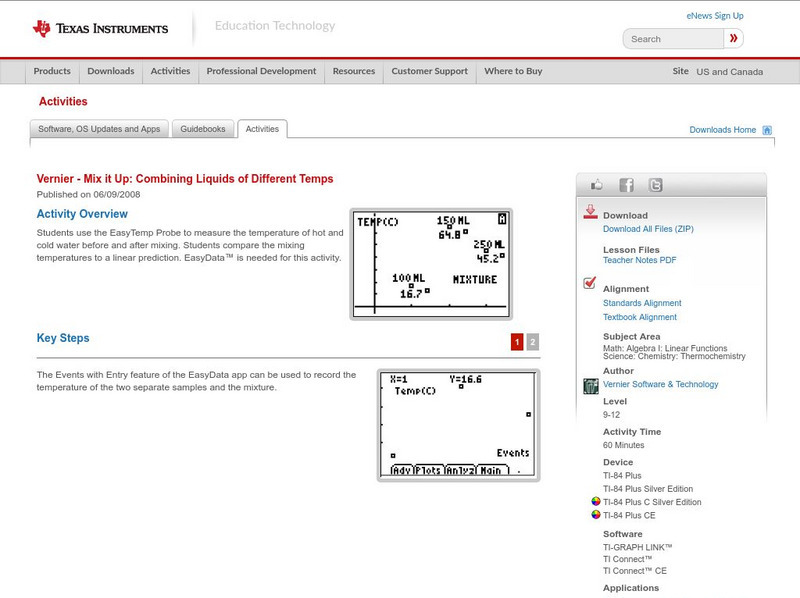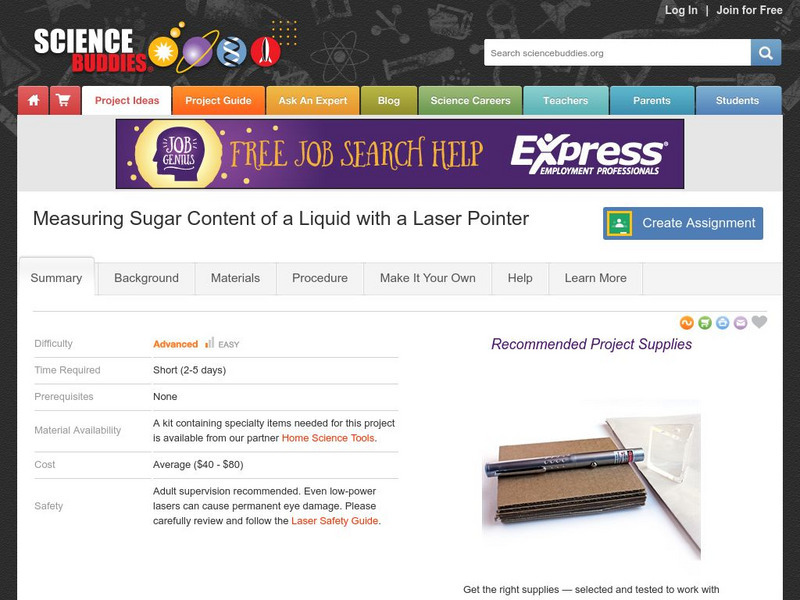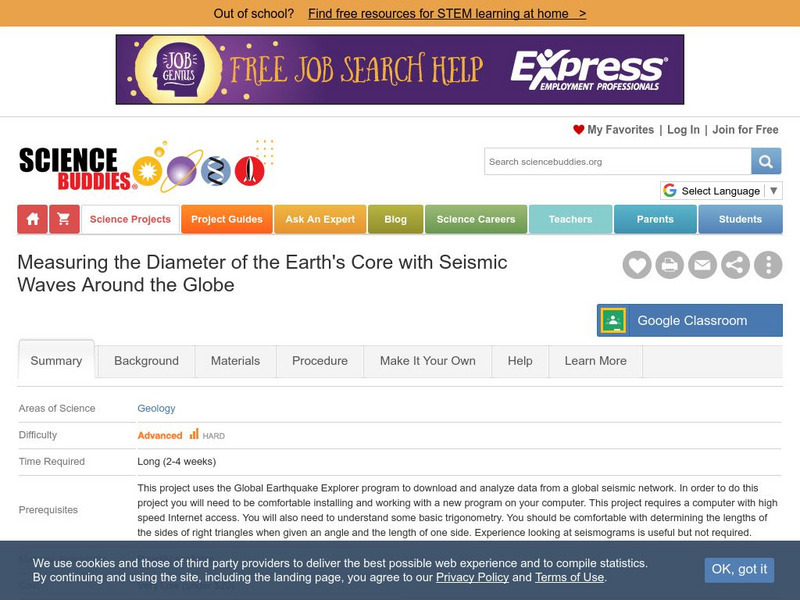Curated OER
The Same But Different
Fourth graders identify the characteristics of a simple physical change. They describe objects by the properties of the materials from which they are made. Students discuss the different states of matter and their distinct physical...
Curated OER
Smog Be Gone
Students begin the instructional activity by identifying greenhouse gases. In groups, they observe and record the effect of the gases on the atmosphere and the temperature of the Earth. They participate in activities that describe the...
Curated OER
DNA Extraction From Living Things
Students extract DNA from split peas. In this biology lesson, students hypothesize what DNA looks like and perform the experiment to verify their hypothesis. They explain the importance of DNA in living things.
Curated OER
Melting and Freezing of Water
High schoolers differentiate the three states of matter. For this chemistry lesson, students analyze graphs of heating and cooling curve of water. They complete a lab report and discuss results.
Curated OER
What's the Matter with My Jell-o?
Students work in teams of four as they conduct four controlled Jell-O experiments over a two-day period. The Family Page extends this learning to the community by providing families with challenges to explore at home.
Science Struck
Science Struck: Liquid Measurement Conversion
Provides tables showing how to convert liquid measurements used for cooking between different customary units and metric units. Covers teaspoons up to gallons, as well as conversions to milliliters.
Science Education Resource Center at Carleton College
Serc: Measuring Liquid Volume
In this lab, young scholars will measure and combine colored liquids to receive the expected results. The intended outcome would be to take primary colored liquids, measure them and combine them to create a "rainbow" colored set of water...
ibiblio
Ibiblio: How Many? A Dictionary of Units of Measurement
The Center for Mathematics and Science Education at the University of North Carolina at Chapel Hill provides an interesting and easy-to-use dictionary of the history and meaning of many measurement terms. Metric, International, and...
Science Struck
Science Struck: Liquid Measurements Chart
Provides tables showing how to convert liquid measurements used for cooking and for container labeling. Covers teaspoons up to gallons, as well as conversions to milliliters. Also explains the differences between British and American...
PBS
Pbs: Standard Measures and Conversions: Liquid Volume, Milliliters and Liters
In this Cyberchase Media Gallery, explore key concepts about liquid volume, including standard units of liquid measure and how to convert between them. In the accompanying classroom activity, students create a complete conversion chart...
abcteach
Abcteach: Math: Measurement
[Free Registration/Login Required] Teachers will find a variety of worksheets, booklets, conversion charts, warm-up activities and more on measurements. There is even one activity that could be used in a French language class which...
Texas Instruments
Texas Instruments: Mix It Up: Mixing Liquids of Different Temperatures
In this activity, students' will use temperature sensors to measure temperatures of water samples before and after mixing. They compare the mixing temperatures to a linear prediction.
Texas Instruments
Texas Instruments: Electrolytes: Which Liquid Produces the Most Volts?
In this activity, students' will use a Voltage Sensor to measure the voltage produced by an electrolyte. They will understand that acids and bases are electrolytes and compare voltages of acids to the voltages of bases. Students' will...
Texas Instruments
Texas Instruments: Mix It Up: Combining Liquids of Different Temps
Students use the EasyTemp Probe to measure the temperature of hot and cold water before and after mixing. Students compare the mixing temperatures to a linear prediction. EasyData is needed for this activity.
Science Buddies
Science Buddies: Measuring Sugar Content of a Liquid With a Laser Pointer
Here's a project that shows you how to use a laser pointer and some knowledge of physics to figure out the concentration of sugar dissolved in a liquid.
Science Buddies
Science Buddies: Measuring the Earth's Core With Seismic Waves
When an earthquake occurs, seismic shock waves travel out through the earth from the source of the event. The shock waves travel through the earth (body waves), or along the Earth's surface (surface waves), and can be recorded at remote...
TeachEngineering
Teach Engineering: Measuring Lava Flow
Students learn how volume, viscosity and slope are factors that affect the surface area that lava covers. Using clear transparency grids and liquid soap, students conduct experiments, make measurements and collect data. They also...
TeachEngineering
Teach Engineering: Measuring Viscosity
Students calculate the viscosity of various household fluids by measuring the amount of time it takes marble or steel balls to fall given distances through the liquids. They experience what viscosity means, and also practice using...
Khan Academy
Khan Academy: Word Problems With Mass
In this exercise, students practice arithmetic word problems with mass. Students receive immediate feedback and have the opportunity to get hints, watch a tutorial video, and try questions repeatedly. CCSS.Math.Content.3.MD.A.2 Measure...
National Council of Teachers of Mathematics
Nctm: Figure This: Drip Drops
Figure out how much water you waste in a week in this exploration using your problem solving, measurement, and estimation skills. This activity is from the NCTM Math Challenges for Families series.
Other
Conversions for Weight Measurements
This site allows you to convert weight/mass measurements. For example converting tons to grams. CCSS.Math.Content.3.MD.A.2 Measure and estimate liquid volumes and masses of objects using standard units
Science Education Resource Center at Carleton College
Serc: Mn Step: Study of Student Precision Using Volumetric Glassware
This activity is an exercise in using various lab equipment for measuring the volume of a liquid. Data is recorded on a spreadsheet and analyzed to see which tool offers the greatest precision.
PBS
Nova Online: How Many Pearls? A Weight & Volume Game
This interactive game has students apply skills in estimation, measurement, and basic addition using pearls. Students are asked to estimate the number of pearls in a treasure chest by making predictions and using number sense. The skills...
Khan Academy
Khan Academy: Estimating Mass
In this exercise, students practice estimating mass. Students receive immediate feedback and have the opportunity to get step-by-step hints and try questions repeatedly. CCSS.Math.Content.3.MD.A.2 Measure and estimate liquid volumes and...






